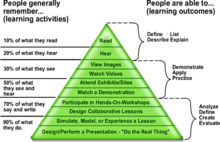Edgar Dale
Edgar Dale (April 27, 1900 in Benson, Minnesota, – March 8, 1985 in Columbus, Ohio) was an American educator who developed the Cone of Experience. He made several contributions to audio and visual instruction, including a methodology for analyzing the content of motion pictures. Born and raised in North Dakota he received a B.A. and M.A. from the University of North Dakota and a Ph.D from the University of Chicago.[1] His doctoral thesis was titled "Factual Basis for Curriculum Revision in Arithmetic with Special Reference to Children's Understanding of Business Terms."[2] and is precursor for his later work with vocabulary and readability. He was a professor of education at Ohio State University.
In 1933 Dale wrote a paper on how to effectively create a high school film appreciation class. This paper has been noted for having a very different view of adolescent interaction with films than that taken by the Film Control Boards of the time.[3]
Early career
He was a teacher in a small rural school in North Dakota (1919–31). He was superintendent of schools at Webster, North Dakota (1921–24), and a teacher at the junior high school at Winnetka, Illinois (1924–26). His interest in film led to position with Eastman Kodak as a member of the editorial staff of Eastman Teaching Films (1928–29).[4]
Cone of Experience

Dale's "Cone of Experience," which he intended to provide an intuitive model of the concreteness of various kinds of audio-visual media, has been widely misrepresented. Often referred to as the "Cone of Learning," it purports to inform viewers of how much people remember based on how they encounter information. However, Dale included no numbers and did not base his cone on scientific research, and he also warned readers not to take the cone too seriously.[5] The numbers originated from 1967, when a Mobile oil company employee named D. G. Treichler published a non-scholarly article in an audio magazine titled Film and Audio-Visual Communications.[6][7]
Awards
Educational Film Library Association Award (1961)
Eastman Kodak Gold Medal Award (1968)
Distinguished Services Award (1972)
National Reading Hall of Fame (1972)
[8][9]
References
- ↑ Wagner, Robert W. Edgar Dale: Professional. Theory into Practice. Vol. 9, No. 2, Edgar Dale (Apr., 1970), pp. 89-95 - http://www.jstor.org/pss/1475566
- ↑ http://pi.lib.uchicago.edu/1001/cat/bib/4174355
- ↑ article about Dale's writing on film appreciation
- ↑ Biographical Dictionary of American Educators, Volume 1
- ↑ Lawrence, William K. (2015-01-01). Learning and Personality: The Experience of Introverted Reflective Learners in a World of Extroverts. Cambridge Scholars Publishing. ISBN 9781443878074.
- ↑ Thalheimer, Will. "People Remember 10%, 20%... Oh Really?" (Oct., 2006) - http://www.willatworklearning.com/2006/10/people_remember.html
- ↑ Lawrence, William K. "The experience of contrasting learning styles, learning preferences, and personality types in the community college English classroom" (Jan., 2014) - http://hdl.handle.net/2047/d20004841
- ↑ Biographical Dictionary of American Educators, Volume 1
- ↑ http://prezi.com/xptp82dt9ysr/edgar-dale/
External links
- See the following webpage for (1) some of the most common misrepresentations, (2) an image of Dale's original cone, and (3) citations.